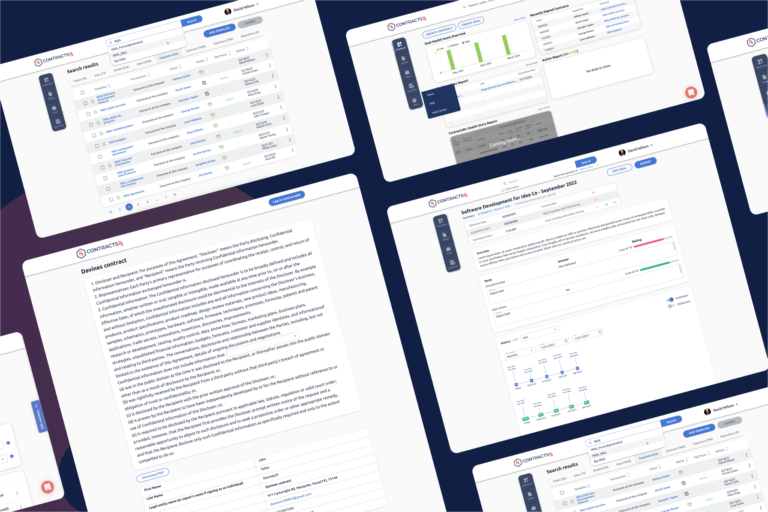Month: August 2023
How to Develop Contract Management Software: Market Overview, Technologies, and Main Features
All businesses, small and large, deal with contracts every day. Some of them need to manage just several deals at a time, while others handle hundred of deals simultaneously.
An old-school method of managing them is manual, but it takes hours. Contract management systems help reduce this time to just minutes and eliminate human error in reading the fine print, assessing risks, and managing the contract’s lifecycle.
In this article, you’ll learn how to build contract management software for your company or a SaaS solution, which you’ll offer other businesses along with customer support.
What is Contract management software?
Software for contract management or Contract lifecycle management (CLM) software is a digital solution that helps businesses manage the entire lifecycle of their deals and documents, store, asses, sign them electronically, and more.
CLM solutions are in a way similar to project management software tools, as they help users to collaborate and track the milestones of each project.
Contract management is a complex, multi-stage process. CLM systems facilitate all parts of its lifecycle, from storing documents in one place to analysing, negotiating and signing deals electronically
Some companies already use a stack of various programs to manage their business contracts, like cloud storage, spreadsheets, CRMs, and other separate tools. Contract management software has these tools in one place and allows businesses to build a clear workflow and automate some of the parts of the contract management process and assessment.
What does contract management software do?
To answer this question, let’s have a look at a typical contract management lifecycle. These are the actions and activities that a business needs to perform in order to create and go through with a deal:
- Create and save a contract
- Build a template to accelerate the document creation process
- Edit a contract
- Add all the collected data accurately to specific clauses
- Send a deal and all supporting documentation to the other party
- Negotiate a contract with another party
- Keep the history of changes that happened during the negotiation process
- Keep track of milestones and compliance standards
- E-sign a deal
- Process the payment
As you can imagine, doing all this in separate tools and places manually can be an extremely daunting task. This is where contract management solutions save the day, allowing everything to happen in one place, online.
According to Markets and Markets, the global contract management software market size is expected to grow from $1.5 billion in 2019 to $2.9 billion by 2024, soaring at a CAGR of 13.5%.
The benefits of contract management software have resulted in a growing number of businesses that use them for optimizing their contracting game. So now, there’s a market for solutions of this type, growing by leaps and bounds.
Contract management software market overview
The market for contract management software has great prospects. According to Markets and Markets, the global contract management software market size is expected to grow from $1.5 billion in 2019 to $2.9 billion by 2024, soaring at a CAGR of 13.5%.
Other surveys have similar predictions: according to Future Market Insights, in 2021 the market of contract management software was valued at $2 billion. With the expected CAGR of 12.5%, it’s anticipated to grow to $5 billion by 2032. Others predict an even starker growth: $5.6 billion by 2030.
The main factors of such growth are:
- The rising demand for agile contract management
- The increasing complexity of business relations expressed in their contracts
- Changes in compliance
- The rising demand for smart contracts
- The advancement in the AI/ML technology
So, let’s now talk about how you can enter this market by building your own contract management solution. We’ll start with technologies and features and then walk through the process of building such software on Mobindustry’s client’s example.
Technologies used in developing contact management software
The technology stack contract management software is built with depends on its complexity. Usually, all CLM software comes in the form of web platforms, web apps, and mobile apps so they can be accessed from all screens. However, smartphone apps often have limited functionality, as they’re inconvenient to use from a user experience standpoint.
Thus, CLM software uses typical web technologies suitable for feature-rich products. For example, DocuSign uses HTML5, Google Analytics, jQuery, PHP, NGINX, Bootstrap, and Varnish.
Our own project ContractRX uses РHP, Angular, MySQL, Yii2, and dozens of other technologies that support this complex system that consists of four separate services for deal analysis, risk assessment, contract creation, and payment processing.
Among the most popular advanced technologies that contract management software uses are artificial intelligence and machine learning. They’re used to process data, identify and assess risks, as well as automate the whole process of contract management.
Let’s now look at the features present in most CLS products.
Top contract management software features
Document storage and management
Here, your users will store all their deals and documents, organize them in folders and have everything in one place. For CLM, I suggest having cloud storage, just like Google Drive, for example, so that the documents can be accessed and updated from anywhere.
Search and filters

You need strong search functionality so that your users can efficiently find exactly what they need in seconds. You can also implement filters that allow users to sort documents by parameters like date of creation.
Company profiles
If you’re building a SaaS solution for other companies, they should be able to create their profiles in your system and manage their settings, payment methods, subscriptions, and of course, content.
Access and role management
Your clients should be able to reflect their company structure in your CLM solution by assigning different roles and levels of access to the documents to their staff members and business partners. Just like in Google Docs, for example, different people may be able to view, comment, or edit a certain document, and this access should depend on their role or permission.
Contract template management
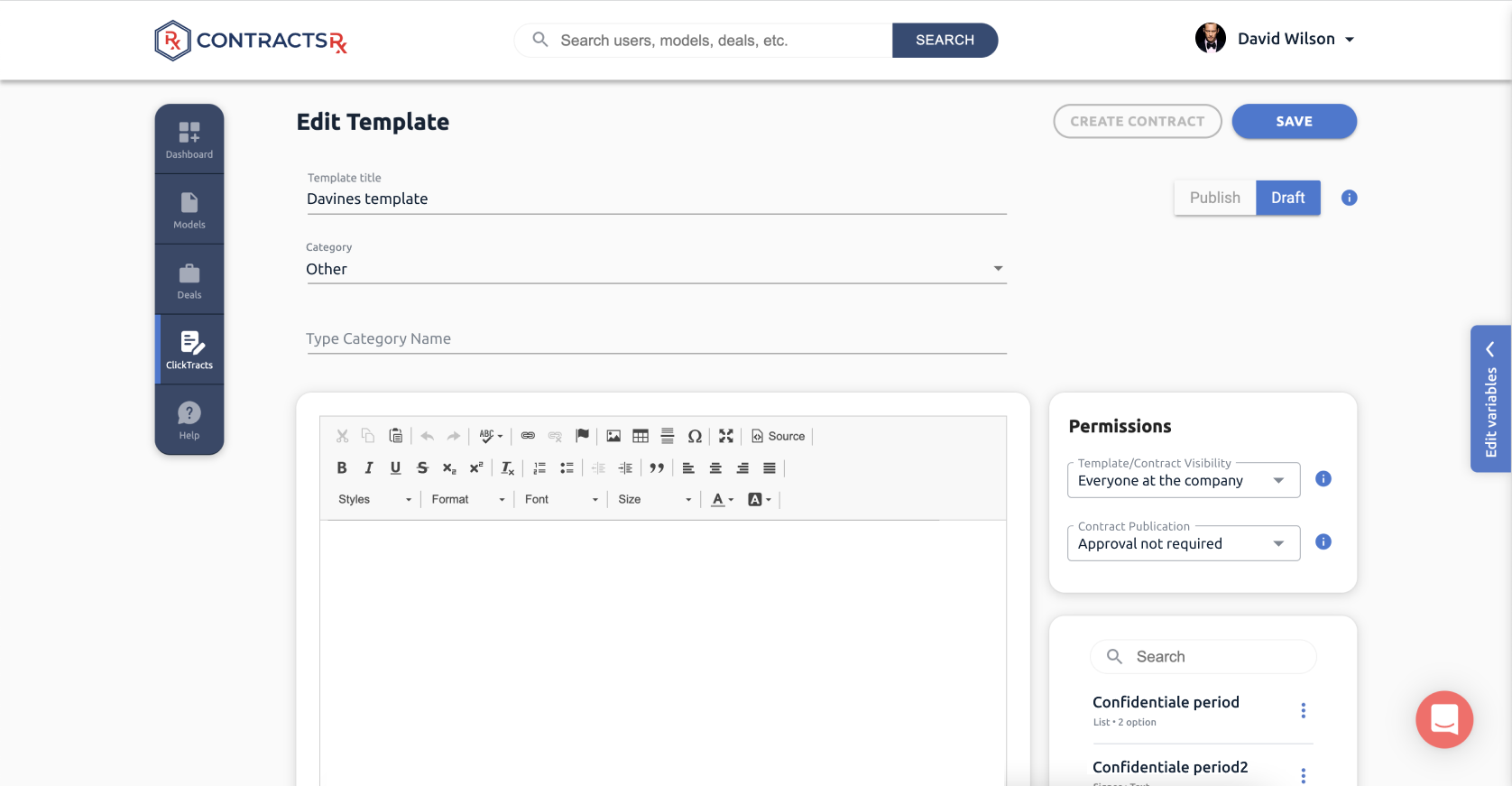
Gives your clients the ability to create contract templates so they can save time on creating their documents. Templates should have flexible layouts and variables, as well as drag-and-drop editing functionality.
Document collaboration and version control
In order to avoid the mess of different document versions being saved in multiple places, your users and their business partners should be able to collaborate on documents in one place and always have access to the history of changes.
Contract link sharing
Your service should be convenient to use even for those not registered on your platform — your clients’ business partners. Link sharing allows your users to send documents to their partners and collaborate on them online.
Comments and chat
Facilitate the negotiation process by adding the ability to leave comments on the deal and chat about specific clauses online without leaving the document and having lengthy scattered email correspondence.
Contract editor
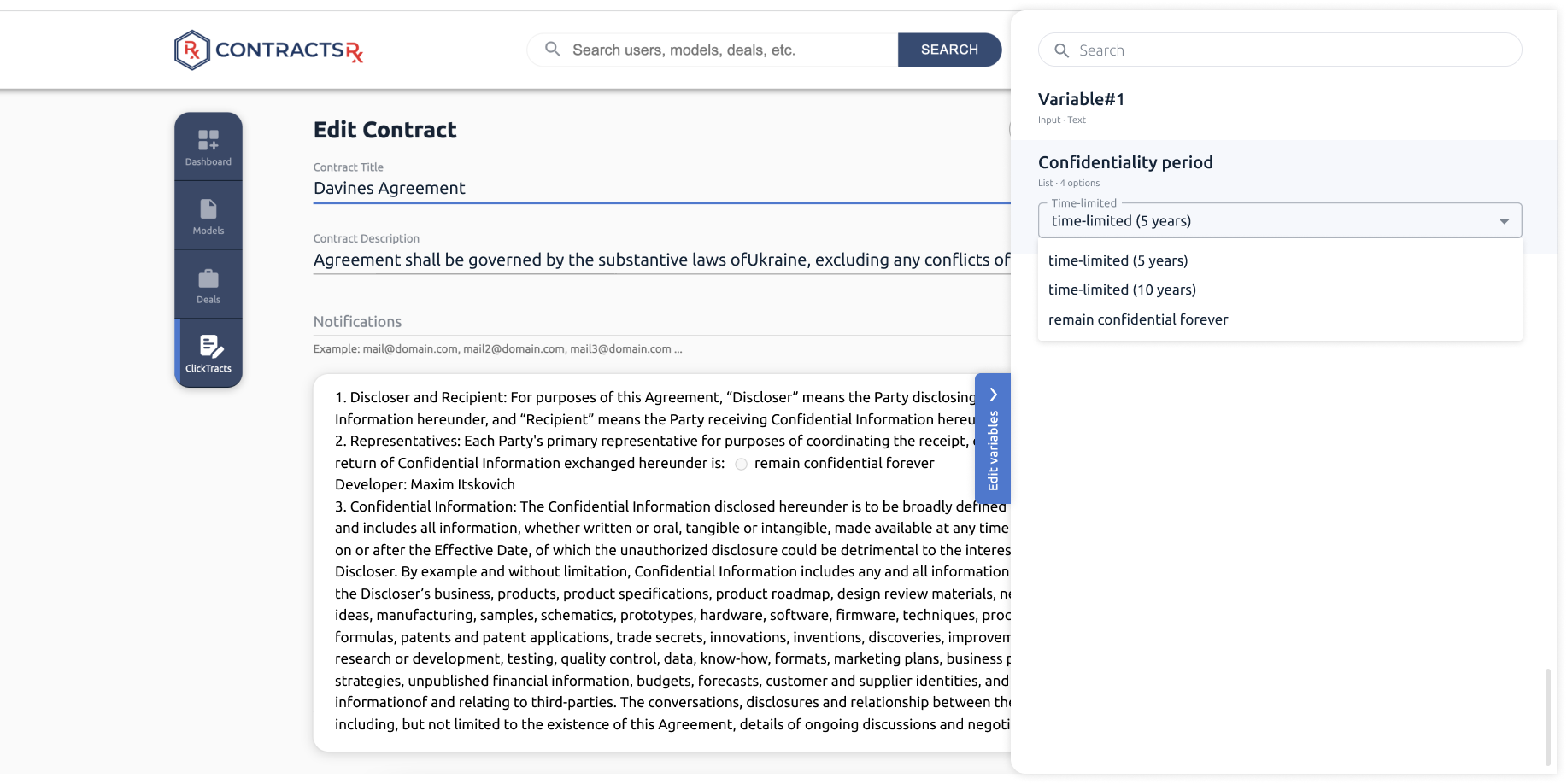
Allow your users and their business partners to edit documents based on their roles and levels of access. The history of edits should be preserved.
Contract scoring
Use specific algorithms to identify the problematic clauses in a deal that may be risky for your clients and score the overall contract health based on its compliance with your clients’ business terms.
Electronic signatures
E-signature is a core feature of any CLM software. You can implement it by integrating your service with another e-signing service like DocuSign.
Contract summaries
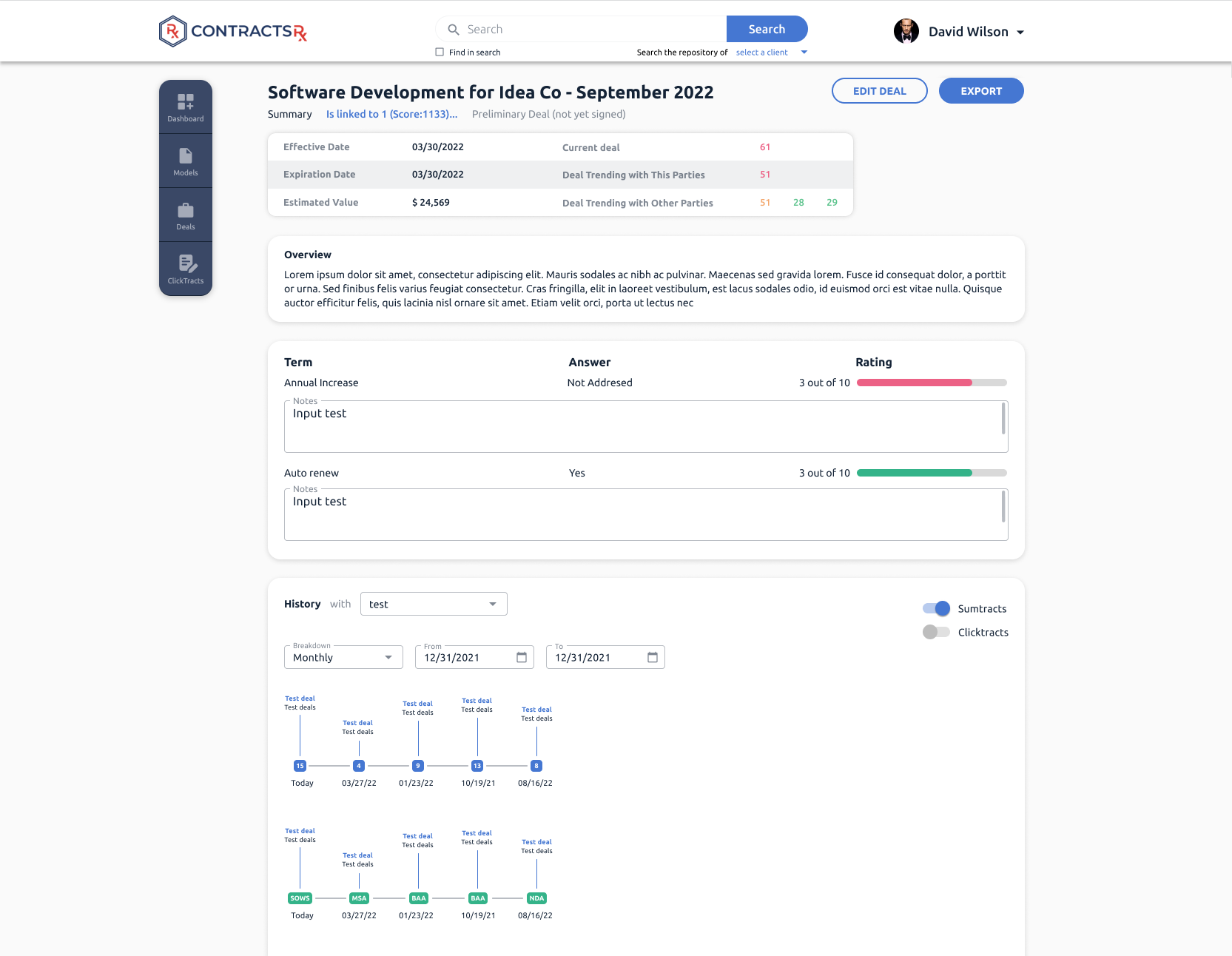
This feature highlights the most important parts of the deal, hidden risks, and costs, as well as previous terms from the history of contracting with a certain partner.
Document export
Your users should be able to download documents in the most popular formats like Docx, PDF, txt, etc.
Validation for e-signatures
You’ll need to authorize your users at the login, but also, every time they electronically sign a document, they need some sort of authorization. It can be done either through a phone number or biometrics.
Notifications and alerts
Notify your users of contract changes during negotiations, deadlines, deal milestones, and more.
Third-party integrations
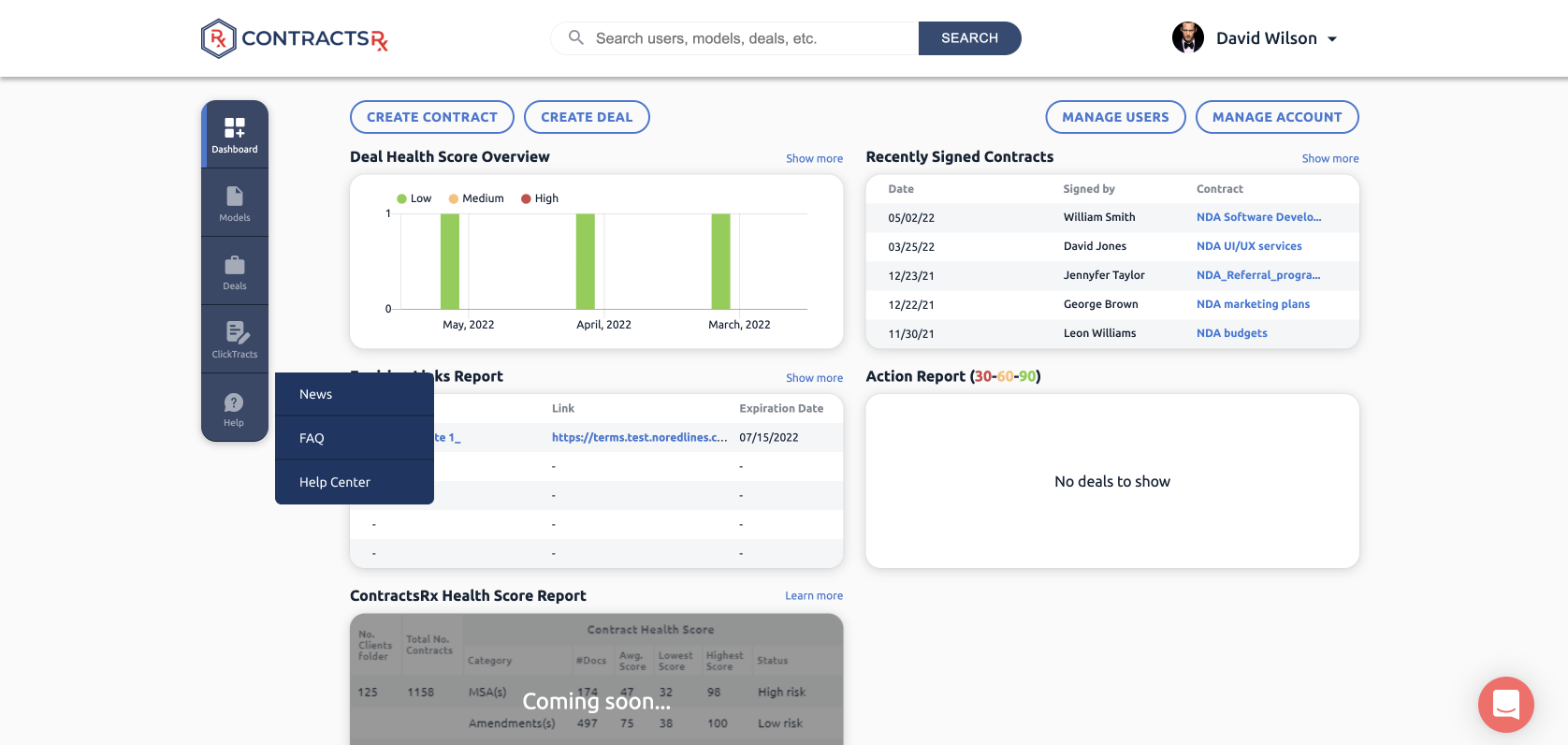
Allow your users to adopt your CLM software into their existing business ecosystem. You can integrate your service with Microsoft, Salesforce, Google, and other services depending on what your target audience uses in their business processes.
Payment processing
Payment processing may be required for two reasons. If you offer a SaaS CLM, your users will need to pay for a subscription. Also, you may allow paying for contracts right through your platform, so you’ll need payment processing for that as well.
Subscription management
This feature is necessary for SaaS CLMs that offer their platform to other businesses to manage their contracts. Subscription management enables users to choose their package, pay for it and cancel their subscription.
Autofill
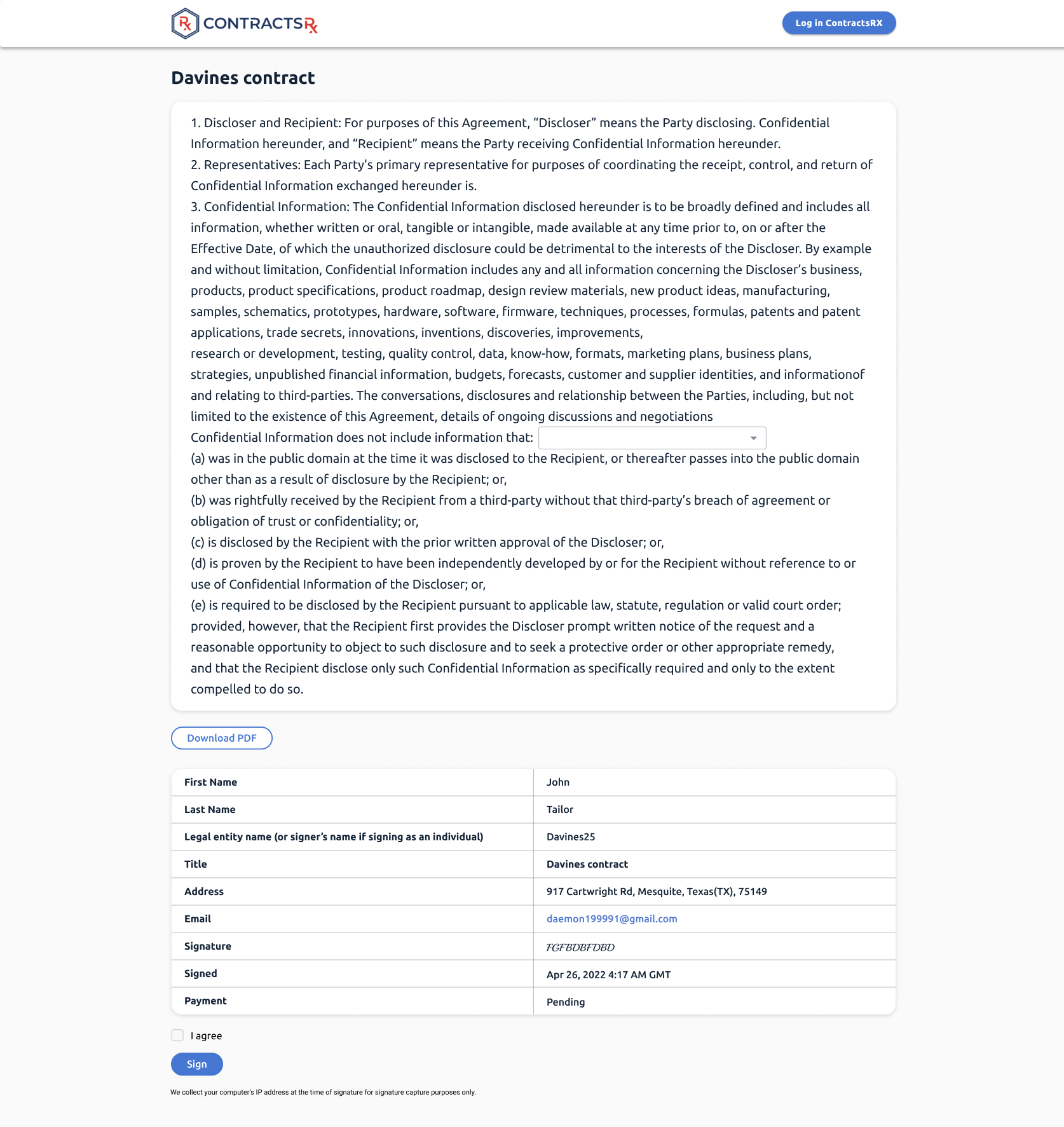
Saving time is the biggest advantage of any CLS, and autofill is one of the features that can accelerate the contracting process.
Compliance auditing
Allow your users to automatically check if their deals are compliant with certain regulations.
Contract management systems are typically feature-rich, and here I listed the features for a solution that covers every aspect of the contract management lifecycle. You can exclude some features or add those that are vital for your particular domain.
When we created ContractRX for our client, we included only the most important functionality in the MVP and then moved further with more clarity thanks to the user feedback.
How to build contract management software
1. Define your vision
Your first step is to define your idea. What should your CLM system look like? What types of businesses in what industries are you looking to attract? For example, contract management is different for domains like retail, healthcare, banking, transportation, and manufacturing.
Your target market will define your product structure, functionality, and logic.
2. Find a reliable vendor
If you don’t have your own software development team, you need to hire a company that will help you go through all stages of CLM system development. You can find a vendor by doing your own research, asking for recommendations, and checking the portfolios.
Make sure your vendor has experience in building systems similar to yours, and they can give you recommendations on how to turn your legal expertise into a software solution.
3. Go through the discovery phase
Customizable contract management software is complex and requires planning, so a discovery phase is necessary. During this phase, a business analyst conducts a series of interviews with you and extracts your requirements for the future CLM solution.
They also perform market research, competitor analysis, and other types of activities to make sure you get a perfect market hit after the release.
As a result of a discovery phase, you’ll get a technical specification containing all details about your product’s functionality, business logic, requirements, wireframes, user experience, and more. You’ll have a full development plan that will guide you, all the stakeholders, and team members toward the common goal.
4. Develop and test your system
Now that the plan is ready, it’s time to develop your system. In order to release your product sooner, you can prioritize features and develop the main functionality first. Thus, you’ll develop an MVP that’s ready for businesses to use and for you — to gather feedback.
5. Release and improve your CLM
After the release, your goal is to gather as much feedback as possible and continue to improve and enrich your system with new functionality. This is especially important for SaaS systems that need to provide constant value to retain their users.
Watch how users behave on your platform, what features matter to them the most, and what bottlenecks in the contracting process can be eliminated.
How much does contract management software engineering cost?
The contract management software cost depends on a multitude of factors like:
- Your system’s functionality and size
- Tech stack
- Design complexity
- Team size
- Deadline
- Your team’s hourly rate
The size and hourly rate of your team are the two most influential factors. The hourly rate of a team depends on the location. For example, two similar teams with the same skill sets in the US and in Ukraine may have up to a 5x difference.
So, if you’d like to optimize your budget, you can hire a team from overseas and develop your product for a lower price without sacrificing quality.
Final thoughts
In this article, you’ve learned how to build a contract management system for your business or as a SaaS solution for other companies. CLM solutions are getting increasingly popular as businesses are looking for ways to eliminate human error and automate their contracting processes.
We at Mobindustry have experience in building a successful CLM system that we’ve grown from a small MVP to a complex multi-product platform that offers multiple services in contract management.
If you have questions about building your own CLM software, don’t hesitate to contact us for a free consultation and a quote.



